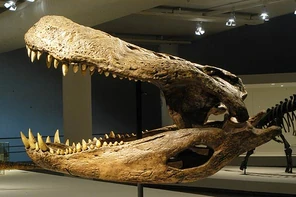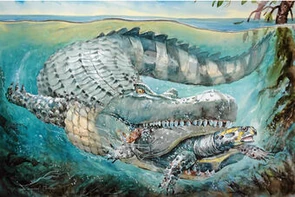Purussaurus is an extinct genus of caiman that lived in South America from the Early to Late Miocene.
Description[]

Credit: Via Tsuji on Flickr.
Purussaurus is known from many remains from a list of Miocene formations. In form, Purussaurus most looked like an alligator, with a blunt and boxy skull. Purussaurus is actually a type of caiman; sitting in Caimaninae, which sits in Alligatoridae. Purussaurus had a skull which was about 1453 millimeters, in the largest species, P. brasiliensis. It is very difficult to determine a definitive size due to most estimates scaling the skull to the rest of the body. Most cases estimate the bite force of Purussaurus was about 52,500 Newtons (about 5.3 metric tons). This factor and the animals massive size makes Purussaurus' diet quite broad, thus making Purussaurus an apex predator.

Purussaurus skull mount.
The teeth of Purussaurus vary between species, but are usually about 50 millimeters (2 inches) long and were slightly recurved. The individual teeth had small ridges along two of the tooth's edges. This indicates that the animal ate large vertebrates, as these types of teeth are specialized for puncturing and holding mounds of flesh. The teeth are also slightly flattened at their peaks, and conical, which makes tooth breakage unlikely when a bone is struck. The teeth located at the anterior end of the mouth are taller and more pointed, which the ones at the posterior end are shorter and blunter. Purussaurus is among the largest crocodyliformes known to have existed, being larger than both Sarcosuchus and Rhamphosuchus who are 9 meters and 8-11 meters respectively. The first two have similar proportions, but are geologically older. However, recent estimates suggest that Deinosuchus and Astorgosuchus could be even larger, with Deinosuchus reaching over 13 meters and weigh 12 tons with the latter reaching 10-12 meters and weighing 8-10 tons Rhamphosuchus lived alongside the same time as Purussaurus, was similar in size, but appeared more gharial-like. Biomechanical studies of Purussaurus' skull show it utilized the classic crocodilian death roll. The death roll is used by crocodilians to stun, subdue, and dismember their prey. It is performed by clamping tightly onto prey, and spinning quickly in the water. All organs used for sense (eyes, ears, nostrils...) are located on the top of its head, indicating that Purussaurus was an ambush predator. Upper estimates for it's bite are 69,000 Newtons (7 metric tons). If these are to be trusted, it would have been one of the greatest bite forces ever, only outmatched by Megalodon[1].
Species[]
Paleoecology[]
Extinction[]
Adult Purussaurus would have preyed on massive animals that lived by the waters side, or were just coming for a drink. Adults would have had little competition with small carnivores. This makes scientist propose that while a large size poses many advantages, one disadvantage is vulnerability in terms of changing climate and environmental changes. This ultimately caused Purussaurus to fall extinct due to it not being to adapt like small caimans can[1].
Paleoenvironment[]

Purussaurus biting down upon a Stupendemys.
Purussaurus lived in the Villavieja, Culebra, Urumaco, Pebas, Solimões, Ituzaingó[2], Castilletes and Socorro Formations. It lived in bodies of water, sharing its habitat with a wide array of animals. Water was inhabited by the turtle Stupendemys, the crocodilians Charactosuchus, Gryposuchus, Mourasuchus, river dolphins and the extant bird genus Anhinga. The land was shared by many mammals; bats, ground sloths, rodents and massive relatives of the capybara. The ape Stirtonia and several ungulates also populated the same areas Purussaurus did. Purussaurus preferred coastal, tropical landscapes from the Early to the Late Miocene, where Purussaurus went extinct[1]. The partial tooth MAS-PV 386 from Toma Vieja, Argentina was described in 2023 and allocated to the genus, but not a specific species. This extends the range of this genus to the Argentinian lower Ituzaingó Formation of Late Miocene strata[2].
References[]
Note: references appear as superscript numbers such as: [1].
|

